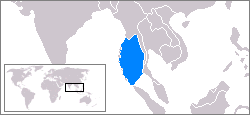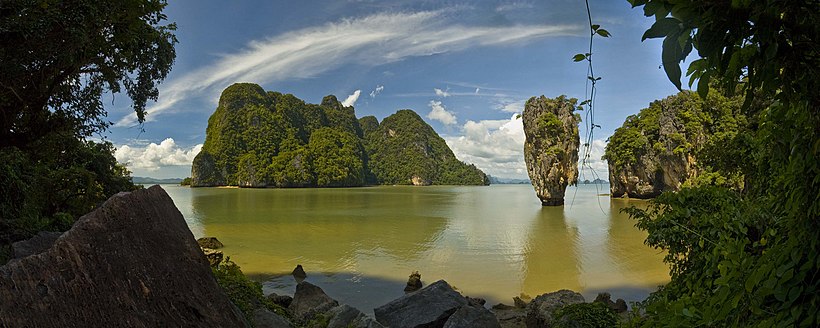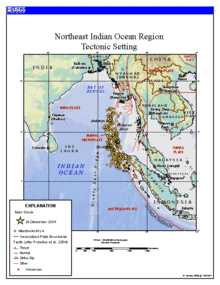Andaman Sea
| Andaman Sea | |
|---|---|
 | |
| Basin countries | Burma, India, Indonesia, Malaysia, Thailand |
| Max. length | 1,200 km (746 mi) |
| Max. width | 645 km (401 mi) |
| Surface area | 600,000 km2 (231,700 sq mi) |
| Average depth | 1,096 m (3,596 ft) |
| Max. depth | 4,198 m (13,773 ft) |
| Water volume | 660,000 km3 (158,000 cu mi) |
| References | [1][2] |
The Andaman Sea (Template:Lang-my, IPA: [mouʔtəma̰]; Template:Lang-th, IPA: [tʰa.leː ʔan.daː.man]) or Burma Sea is a body of water to the southeast of the Bay of Bengal, south of Burma, west of Thailand and east of the Andaman Islands, India; it is part of the Indian Ocean.
The sea has been traditionally used for fishery and transportation of goods between the coastal countries and its coral reefs and islands are popular tourist destinations. The fishery and tourist infrastructure has been severely damaged by the 2004 Indian Ocean earthquake and tsunami.
Extent
At its southeastern reaches, the Andaman Sea narrows to form the Straits of Malacca, which separate the Malay Peninsula from the island of Sumatra.
The International Hydrographic Organization defines the limits of the "Andaman or Burma Sea" as follows:[3]
On the Southwest. A line running from Oedjong Raja (5°32′N 95°12′E / 5.533°N 95.200°E) in Sumatra to Poeloe Bras (Breuëh) and on through the Western Islands of the Nicobar Group to Sandy Point in Little Andaman Island, in such a way that all the narrow waters appertain to the Burma Sea.
On the Northwest. The Eastern limit of the Bay of Bengal [A line running from Cape Negrais (16°03'N) in Burma through the larger islands of the Andaman group, in such a way that all the narrow waters between the islands lie to the Eastward of the line and are excluded from the Bay of Bengal, as far as a point in Little Andaman Island].
On the Southeast. A line joining Lem Voalan (7°47'N) in Siam [Thailand], and Pedropunt (5°40'N) in Sumatra.
Geology


The average depth of the sea is about 1,000 meters (3,300 ft). The northern and eastern parts are shallower than 180 meters (600 ft) due to the silt deposited by the Irrawaddy River. This major river flows into the sea from the north through Burma. The western and central areas are 900–3,000 meters deep (3,000–10,000 ft). Less than 5% of the sea is deeper than 3,000 meters (10,000 ft), and in a system of submarine valleys east of the Andaman-Nicobar Ridge, the depth exceeds 4,000 meters (13,200 ft).[2] The sea floor is covered with pebbles, gravel and sand.[1]
Hydrology and climate
The climate and water salinity of the Andaman Sea are mostly determined by the monsoons of southeast Asia. Air temperature is stable over the year at 26 °C in February and 27 °C in August. Precipitation is as high as 3,000 mm/year and mostly occurs in summer. Sea currents are south-easterly and easterly in winter and south-westerly and westerly in summer. The average surface water temperature is 26–28 °C in February and 29 °C in May. The water temperature is constant at 4.8 °C at the depths of 1,600 m and below. Salinity is 31.5–32.5‰ (parts per thousand) in summer and 30.0–33.0‰ in winter in the southern part. In the northern part, it decreases to 20–25‰ due to the inflow of fresh water from the Irrawaddy River. Tides are semidiurnal (i.e. rising twice a day) with the amplitude of up to 7.2 meters.[1]
Flora
The coastal areas of the Andaman Sea are characterized by mangrove forests and seagrass meadows. Mangroves cover between more than 600 km² of the Thai shores of Malay Peninsula whereas seagrass meadows occupy an area of 79 km².[4] Mangroves are largely responsible for the high productivity of the coastal waters – their roots trap soil and sediment and provide shelter from predators and nursery for fish and small aquatic organisms. Their body protects the shore from the wind and waves, and their detritus are a part of the aquatic food chain. A significant part of the Thai mangrove forests in the Andaman Sea was removed during the extensive brackish water shrimp. Mangroves were also significantly damaged by the 2004 tsunami. They were partly replanted after that, but their area is still gradually decreasing due to human activities.[5]
Other important sources of nutrients in the Andaman Sea are seagrass and the mud bottoms of lagoons and coastal areas. They also create a habitat or temporal shelter for many burrowing and benthic organisms. Many aquatic species migrate from and to seagrass either daily or at certain stages of their life cycle. The human activities which damage seagrass beds include waste water discharge from coastal industry, shrimp farms and other forms of coastal development, as well as trawling and the use of push nets and dragnets. The 2004 tsunami affected 3.5% of seagrass areas along the Andaman Sea via siltation and sand sedimentation and 1.5% suffered total habitat loss.[6]
Fauna


The sea waters along the Malay Peninsula favor molluscan growth, and there are about 280 edible fish species belonging to 75 families. Of those, 232 species (69 families) are found in mangroves and 149 species (51 families) reside in seagrass; so 101 species are common to both habitats.[7] The sea also hosts many vulnerable fauna species, including dugong (Dugong dugon), several dolphin species, such as Irrawaddy Dolphin (Orcaella brevirostris) and four species of sea turtles: critically endangered leatherback turtle (Dermochelys coriacea) and hawksbill turtle (Eletmochelys imbricata) and threatened green turtle (Chelonia mydas) and Olive Ridley turtle (Lepidochelys olivacea). There are only about 150 dugongs in the Andaman Sea, scattered between Ranong and Satun provinces. These species are rather sensitive to the degradation of seagrass meadows.[8]
Human activities
The sea has been used for fishing and transportation of goods between the coastal countries. Thailand alone has produced about 943,000 tonnes in 2005[9] and about 710,000 tonnes in 2000. Of those 710,000 tonnes, 490,000 account for trawling (1,017 vessels), 184,000 for purse seine (415 vessels) and about 30,000 for gillnets. The production numbers are significantly smaller for Malaysia and are comparable, or higher, for Burma.[10] Competition for fish resulted in numerous conflicts between Burma and Thailand. In 1998 and 1999, they resulted in fatalities on both sides and nearly escalated into a military conflict between these countries. In both cases, Thai navy intervened when Burmese vessels tried to intercept Thai fishing boats in the contested sea areas, and Thai fighter aircraft were thought to be deployed by the National Security Council. Thai fishing boats were also frequently confronted by the Malaysian navy to the extent that Thai government had to caution its own fishermen against fishing without license, in foreign waters.[11]
The 2004 marine production in Thailand was divided as follows: pelagic fish 33%, demersal fish 18%, cephalopod 7.5%, crustaceans 4.5%, trash fish 30% and others 7%.[12] Trash fish refers to non-edible species, edible species of low commercial value and juveniles, which are released to the sea.[13] Pelagic fishes were distributed between anchovies (Stolephorus spp., 19%), Indo-Pacific mackerel (Rastrelliger brachysoma, 18%), sardinellas (Sardinellars spp., 14%), scad (11%), longtail tuna (Thunnus tonggol, 9%), eastern little tuna (Euthynnus affinis, 6%), trevallies (6%), bigeye scad (5%), Indian mackerel (Rastrelliger kanagurta, 4%), king mackerel (Scomberomorus cavalla, 3%), torpedo scad (Megalaspis cordyla , 2%), wolf herrings (1%) and others (2%).[14] Demersal fish production was dominated by purple-spotted bigeye (Priacanthus tayenus), threadfin bream (Nemipterus hexodon), brushtooth lizardfish (Saurida undosquamis), slender lizardfish (Saurida elongata) and Jinga shrimp (Metapenaeus affinis).[13] Most species are overfished since 1970s–1990s, except for Spanish mackerel (Scomberomorus commersoni), carangidae and torpedo scad (Meggalaspis spp.). The overal overfishing rate was 333% for pelagic and 245% for demersal species in 1991.[15] Cephalopods are divided into squid, cuttlefish and molluscs, where squid and cuttlefish in Thai waters consists of 10 families, 17 genera and over 30 species. The main mollusk species captured in the Andaman Sea are scallop, blood cockle (Anadara granosa) and short-necked clam. Their collection requires bottom dredge gears, which damage the sea floor and the gears themselves and are becoming unpopular. So, the mollusk production has decreased from 27,374 tonnes in 1999 to 318 tonnes in 2004. While crustaceans composed only 4.5% of the total marine products in 2004 by volume, they accounted for 21% of the total value. They were dominated by banana prawn, tiger prawn, king prawn, school prawn, bay lobster (Thenus orientalis), mantis shrimp, swimming crabs and mud crabs[disambiguation needed]. The total catch in 2004 was 51,607 tonnes for squid and cuttlefish and 36,071 tonnes for crustaceans.[16]
The sea’s mineral resources include tin deposits off the coasts of Malaysia and Thailand. Major ports are Dawei, Mawlamyine, Mergui, Pathein and Yangon in Burma; George Town and Penang in Malaysia; and Belawan in Indonesia.[2]
The Andaman Sea, particularly the western coast of Malay Peninsula, is rich in coral reefs and offshore islands with spectacular topography, such as Phuket, Phi Phi Islands, Ko Tapu and islands of Krabi Province. Despite having been devastated by the 2004 Sumatra earthquake and tsunami, they remain popular tourist destinations.[17] The nearby coast also has numerous marine national parks – 16 only in Thailand, and four of them are candidates for inclusion into UNESCO World Heritage Sites.[18]


Ocean floor tectonics


Running in a rough north-south line on the seabed of the Andaman Sea is the boundary between two tectonic plates, the Burma plate and the Sunda Plate. These plates (or microplates) are believed to have formerly been part of the larger Eurasian Plate, but were formed when transform fault activity intensified as the Indian Plate began its substantive collision with the Eurasian continent. As a result, a back-arc basin center was created, which began to form the marginal basin which would become the Andaman Sea, the current stages of which commenced approximately 3–4 million years ago (Ma).[19]
The boundary between two major tectonic plates results in high seismic activity in the region (see Category:Earthquakes in Indonesia). Numerous earthquakes have been recorded, and at least six, in 1797, 1833, 1861, 2004, 2005 and 2007, had the magnitude of 8.4 or higher. On December 26, 2004, a large portion of the boundary between the Burma Plate and the Indo-Australian Plate slipped, causing the 2004 Indian Ocean earthquake. This megathrust earthquake had a magnitude of 9.3. Between 1300 and 1600 kilometers of the boundary underwent thrust faulting and shifted by about 20 meters, with the sea floor being uplifted several meters.[20] This rise in the sea floor generated a massive tsunami with an estimated height of 28 meters (30 ft)[21] that killed approximately 280,000 people along the coast of the Indian Ocean.[22] The initial quake was followed by a series of aftershocks along the arc of the Andaman and Nicobar Islands. The entire event severely damaged the tourist and fishing infrastructure.[23] The 2000s energy crisis also adversely affected the fishery.[24]
Volcanic activity

Within the sea, to the east of the main Great Andaman island group, lies Barren Island, the only presently active volcano associated with the Indian subcontinent. This island-volcano is 3 km in diameter and rises 354 meters above the seal level. Its recent activity resumed in 1991 after a quiet period of almost 200 years.[25] It is caused by the ongoing subduction of the India Plate beneath the Andaman island arc, which forces magma to rise in this location of the Burma Plate. The last eruption has started on 13 May 2008 and still continues.[26] The volcanic island of Narcondam which lies further to the north was also formed by this process; however, no records exist of its activity.[27]
See also
References
- ^ a b c Andaman Sea, Great Soviet Encyclopedia (in Russian)
- ^ a b c Andaman Sea, Encyclopedia Britannica on-line
- ^ "Limits of Oceans and Seas, 3rd edition" (PDF). International Hydrographic Organization. 1953. Retrieved 7 February 2010.
- ^ Panjarat, pp. 25–26
- ^ Panjarat, pp. 6–7
- ^ Panjarat, p. 7
- ^ Panjarat, p. 26
- ^ Panjarat, p. 8
- ^ Review of Fisheries in OECD Countries 2009: Policies and Summary Statistics, OECD Publishing, 2010 ISBN 9264079742 p. 403
- ^ Cassandra De Young Indian Ocean, Food & Agriculture Org., 2006 ISBN 9251054991, pp. 39, 178
- ^ Alan Dupont East Asia imperilled: transnational challenges to security, Cambridge University Press, 2001 ISBN 0521010152 pp. 103–105
- ^ Panjarat, p. 12
- ^ a b Panjarat, p. 16
- ^ Panjarat, p. 13
- ^ Panjarat, p. 14
- ^ Panjarat, pp. 18–19
- ^ World and Its Peoples: Eastern and Southern Asia, Marshall Cavendish, 2007 ISBN 0761476318 p. 585
- ^ Panjarat, pp. 7–8
- ^ Curray, JR. "2002 Chapman Conference on Continent – Ocean Interactions within the East Asian Marginal Seas" (PDF). Tectonics and History of the Andaman Sea Region (abstract).
- ^ "Implications of the 26 December 2004 Sumatra–Andaman Earthquake on Tsunami Forecast and Assessment Models for Great Subduction-Zone Earthquakes" (PDF). Bulletin of the Seismological Society of America. 97 (1A): S249–S270. doi:10.1785/0120050619.
- ^ New findings super-size our tsunami threat. 80-foot waves blasted Indonesia, scientists now say, February 7, 2005
- ^ Indonesia quake toll jumps again, BBC, 25 January 2005
- ^ Panjarat, pp. 40–42
- ^ Panjarat, pp. 42–44
- ^ D. Chandrasekharam, Jochen Bundschuh (2002) Geothermal energy resources for developing countries, Taylor & Francis ISBN 9058095223 p. 408
- ^ Barren Island, Smithsonian National Museum of Natural History
- ^ Narcondum, Smithsonian National Museum of Natural History
Bibliography
- Panjarat, Sampan Sustainable fisheries in the Andaman Sea coast of Thailand, Division for ocean affairs and the law of the sea office of legal affairs, the United Nations, New York, 2008
